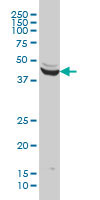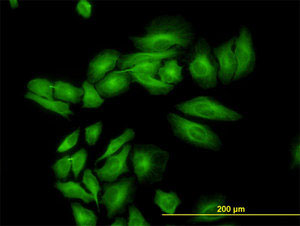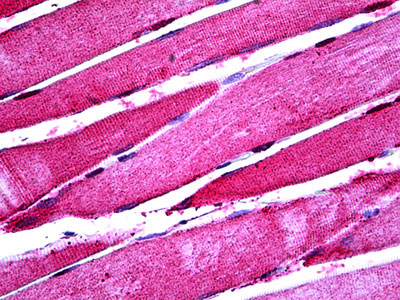ENO3 / Enolase 3 Antibody (clone 5D1)
Mouse Monoclonal Antibody
- SPECIFICATION
- CITATIONS
- PROTOCOLS
- BACKGROUND

Application
| WB, IHC-P, IF, E |
|---|---|
| Primary Accession | P13929 |
| Reactivity | Human |
| Host | Mouse |
| Clonality | Monoclonal |
| Clone Names | 5D1 |
| Calculated MW | 47kDa |
| Dilution | IF (10 µg/ml), IHC-P (5 µg/ml), |
| Gene ID | 2027 |
|---|---|
| Other Names | Beta-enolase, 4.2.1.11, 2-phospho-D-glycerate hydro-lyase, Enolase 3, Muscle-specific enolase, MSE, Skeletal muscle enolase, ENO3 |
| Target/Specificity | Human ENO3 |
| Reconstitution & Storage | Short term 4°C, long term aliquot and store at -20°C, avoid freeze thaw cycles. |
| Precautions | ENO3 / Enolase 3 Antibody (clone 5D1) is for research use only and not for use in diagnostic or therapeutic procedures. |
| Name | ENO3 |
|---|---|
| Function | Glycolytic enzyme that catalyzes the conversion of 2- phosphoglycerate to phosphoenolpyruvate. Appears to have a function in striated muscle development and regeneration. |
| Cellular Location | Cytoplasm. Note=Localized to the Z line. Some colocalization with CKM at M-band (By similarity). |
| Tissue Location | The alpha/alpha homodimer is expressed in embryo and in most adult tissues. The alpha/beta heterodimer and the beta/beta homodimer are found in striated muscle, and the alpha/gamma heterodimer and the gamma/gamma homodimer in neurons |

Thousands of laboratories across the world have published research that depended on the performance of antibodies from Abcepta to advance their research. Check out links to articles that cite our products in major peer-reviewed journals, organized by research category.
info@abcepta.com, and receive a free "I Love Antibodies" mug.
Provided below are standard protocols that you may find useful for product applications.
Background
Appears to have a function in striated muscle development and regeneration.
References
Peshavaria M.,et al.Nucleic Acids Res. 17:8862-8862(1989).
Cali L.,et al.Nucleic Acids Res. 18:1893-1893(1990).
Peshavaria M.,et al.Biochem. J. 275:427-433(1991).
Giallongo A.,et al.Eur. J. Biochem. 214:367-374(1993).
Ota T.,et al.Nat. Genet. 36:40-45(2004).
If you have used an Abcepta product and would like to share how it has performed, please click on the "Submit Review" button and provide the requested information. Our staff will examine and post your review and contact you if needed.
If you have any additional inquiries please email technical services at tech@abcepta.com.













 Foundational characteristics of cancer include proliferation, angiogenesis, migration, evasion of apoptosis, and cellular immortality. Find key markers for these cellular processes and antibodies to detect them.
Foundational characteristics of cancer include proliferation, angiogenesis, migration, evasion of apoptosis, and cellular immortality. Find key markers for these cellular processes and antibodies to detect them. The SUMOplot™ Analysis Program predicts and scores sumoylation sites in your protein. SUMOylation is a post-translational modification involved in various cellular processes, such as nuclear-cytosolic transport, transcriptional regulation, apoptosis, protein stability, response to stress, and progression through the cell cycle.
The SUMOplot™ Analysis Program predicts and scores sumoylation sites in your protein. SUMOylation is a post-translational modification involved in various cellular processes, such as nuclear-cytosolic transport, transcriptional regulation, apoptosis, protein stability, response to stress, and progression through the cell cycle. The Autophagy Receptor Motif Plotter predicts and scores autophagy receptor binding sites in your protein. Identifying proteins connected to this pathway is critical to understanding the role of autophagy in physiological as well as pathological processes such as development, differentiation, neurodegenerative diseases, stress, infection, and cancer.
The Autophagy Receptor Motif Plotter predicts and scores autophagy receptor binding sites in your protein. Identifying proteins connected to this pathway is critical to understanding the role of autophagy in physiological as well as pathological processes such as development, differentiation, neurodegenerative diseases, stress, infection, and cancer.





